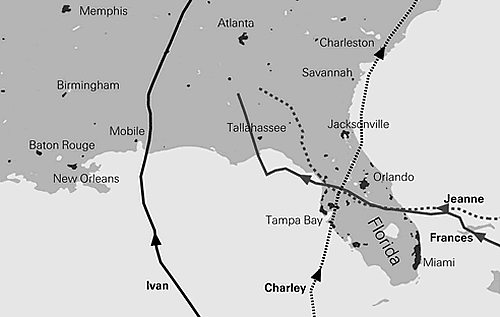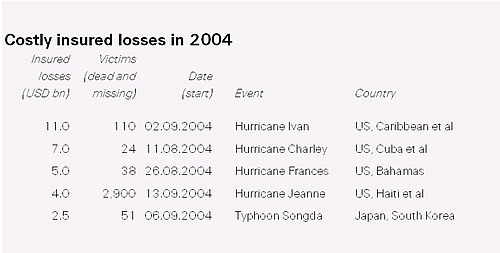According to preliminary Swiss Re sigma estimates, more than 21,000 people around the world lost their lives as a result of natural and man-made catastrophes in 2004. The catastrophes caused overall economic losses of about USD 105 billion worldwide. Property insurers across the globe had to contend with claims of approximately USD 42 billion.
16 Dec 2004 CET – At the time of going to press, around 300 natural and man-made catastrophes around the world had been registered in 2004, claiming the lives of more than 21,000 people and causing total economic damage of approximately USD 105 billion. Property insurers worldwide will bear USD 42 billion of the total losses, thus making 2004 � after 1992, 1999 and 2001 � another record year in terms of insurance claims. About 95% of claims were attributable to natural catastrophes.
The largest claims occurred in the US and Japan: the US, Caribbean, Gulf of Mexico and parts of the Atlantic Basin were hit by a series of hurricanes in August and September. For the first time since 1886, three hurricanes, Charley, Frances and Jeanne, made landfall in the same state � Florida; Ivan made landfall in Alabama, but continued its path across Florida. All four hurricanes caused losses in the billions. Charley wrought economic damage of USD 16 billion, including insurance claims of USD 7 billion. The figures for the other hurricanes were: Frances USD 10 billion and 5 billion, respectively; Jeanne USD 8 billion and 4 billion, respectively; and Ivan USD 22 billion and 11 billion, respectively.
Japan experienced the highest number of typhoons for decades in the period June to October. Typhoon Songda caused total economic losses of USD 6.2 billion, including property claims of 2.5 billion. The figures for Typhoon Tokage were USD 1.4 and 0.8 billion, respectively; and for Typhoon Chaba, USD 1.8 billion and 0.7 billion, respectively. In addition, the region of Niigata, already reeling from Typhoon Tokage, was hit in October by the Chuetsu earthquake (registering 6.9 on the Richter scale) and strong aftershocks.
The total economic losses caused by the earthquake and attendant landslides along with infrastructure damage are estimated at USD 19 to 28 billion, including insurance claims of USD 0.6 billion. Europe had to cope with fewer natural catastrophes than in previous years. However, 191 people were killed and more than 2,000 injured in March following a terrorist attack on Madrid train stations.
Developing countries again suffered the highest number of fatalities in 2004. In Haiti, flooding claimed more than 3,300 lives in May; in September, Hurricane Jeanne killed another 2,900 on the island. Of the 21,000 victims of catastrophes recorded by sigma in 2004, almost half were in Asia or Africa: storms and flooding in the Philippines from mid-November to early December were responsible for over 1,700 deaths. In February, 640 people lost their lives in an earthquake in Morocco; and in March more than 360 people were killed by Cyclone Gafilo in Madagascar.
Burden for property insurers: rising trend
It is still not possible to put a final figure on the losses, particularly in regions hit by more than one catastrophe. However, it is clear that, with insurance claims of around USD 42 billion, 2004 will go down as one of the most expensive in recent history. By way of comparison: in 1992, losses adjusted for inflation were in the region of USD 38 billion (including Hurricane Andrew); in 2001 they reached USD 37 billion (including the 11 September terrorist attack); and in 1999, they totalled USD 36 billion (including the Lothar and Martin winter storms). Thus 2004 reinforces the trend towards higher losses, which can be attributed in part to rising population densities and value concentrations as well as to the growing urbanisation of exposed areas.
US hurricanes in 2004



Glossary of sigma catastrophe statistics
| Natural catastrophes | Loss events triggered by natural forces |
| Man-made/technical disasters | Loss events associated with human activities |
| Economic losses | Losses with a direct economic impact |
| Insured loss | That part of the economic lossed covered by insurance contracts |
Notes to editors
Swiss Re is one of the world’s leading reinsurers and the world’s largest life and health reinsurer. The company operates through more than 70 offices in over 30 countries. Swiss Re has been in the reinsurance business since its foundation in Zurich, Switzerland, in 1863. Through its three business groups Property & Casualty, Life & Health and Financial Services, Swiss Re offers a wide variety of products to manage capital and risk. Traditional reinsurance products, including a broad range of property and casualty as well as life and health covers and related services, are complemented by insurance-based corporate finance solutions and supplementary services for comprehensive risk management. Swiss Re is rated “AA” by Standard & Poor�s, “Aa2” by Moody�s and “A+” by AM Best.




